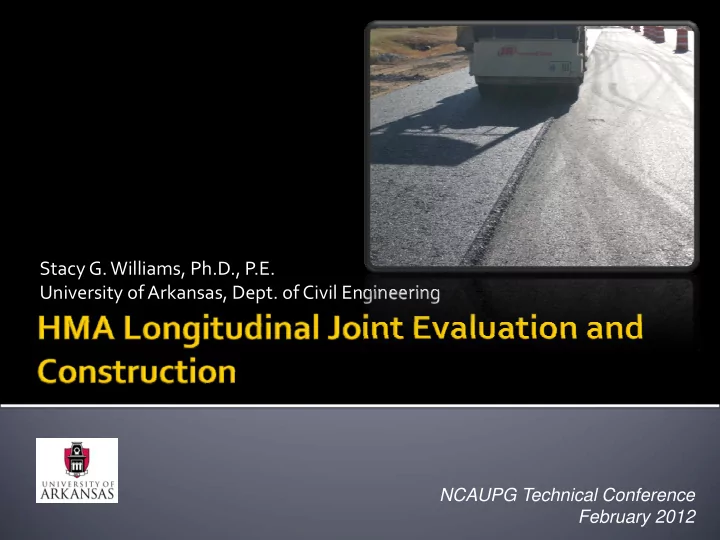

Stacy G. Williams, Ph.D., P.E. University of Arkansas, Dept. of Civil Engineering NCAUPG Technical Conference February 2012
1 - 5% lower than mat density Cold Lane Hot Lane
� Low Density � Permeability � Gradation � What should we measure?
� 3 Projects 12” 6” 6” 12” “Good” “Bad” “Ugly”
100 Nuclear Density (% of TMD) 95 Station 1 90 Station 2 Station 3 Station 4 85 80 12C 6C J 6H 12H 12C 6C J 6H 12H 12C 6C J 6H 12H Project 1 Project 2 Project 3
100 Core Density by SSD (% of TMD) 95 Station 1 90 Station 2 Station 3 Station 4 85 80 12C 6C J 6H 12H 12C 6C J 6H 12H 12C 6C J 6H 12H Project 1 Project 2 Project 3
100 Core Density - CoreLok (% TMD) 95 Station 1 90 Station 2 Station 3 Station 4 85 80 12C 6C J 6H 12H 12C 6C J 6H 12H 12C 6C J 6H 12H Project 1 Project 2 Project 3
3.5 3.0 2.5 Infiltration (cm/hr) 2.0 Station 1 Station 2 1.5 Station 3 Station 4 1.0 0.5 0.0 12C 6C J 6H 12H 12C 6C J 6H 12H 12C 6C J 6H 12H Project 1 Project 2 Project 3
� Discrimination � Density – all methods significant ▪ CoreLok provided greater discrimination than SSD � Permeability – significant ▪ Joint ≠ away from joint, successfully separated projects � Accuracy � Density – most ranked correctly ▪ CoreLok and SSD best ▪ Nuclear – trouble consistently identifying marginal quality � Permeability - 2/3 ranked correctly � Gradation – approx. ½ ranked correctly
� 2 Jobs � 3 testing locations at each section � Joint Construction Techniques � 8 methods (sections) on each job � Testing � Density (field and laboratory) � Field Permeability / Infiltration
� Overlap � Safety Edge � Aggregate Interlock www.transtechsys.com
� Bond cold and hot side of joint � Reduce permeability
� Polymerized emulsion � Penetrates surface � Stabilizes joint
� Same as used for mainline paving operations
Hot Lane Cold Lane
Hot Lane Cold Lane
Hot Lane Cold Lane
� 2 Projects � 500 ft sections for each of 8 methods � 3 locations in each section M 5’ 12H 12” 6H 6” J 6” 12” 6C 12C
Nuclear Density 94 92 90 12C Density, % 6C 88 J 86 6H 84 12H 82 80 CF CR HO HP JB JH NW TC
Core Density -T166 94 92 T166 Density, % 90 6C 88 J 86 6H 84 82 80 CF CR HO HP JB JH NW TC
Core Density -T331 94 92 90 T331 Density, % 88 6C J 86 6H 84 82 80 CF CR HO HP JB JH NW TC
Core Absorption 8 7 6 Absorption, % 5 6C 4 J 3 6H 2 1 0 CF CR HO HP JB JH NW TC
Field Permeability 8000 7000 6000 k, cm/s x 10 -5 5000 6C 4000 J 3000 6H 2000 1000 0 CF CR HO HP JB JH NW TC
Infiltration 1400 1200 Infiltration, cm/hr 1000 6C 800 J 600 6H 400 200 0 CF CR HO HP JB JH NW TC
� Construction method – significant � Distance from joint – significant � Interaction – significant � Permeability / Infiltration ▪ JB and JH – Low permeability at and away from the joint ▪ Others – High permeability at joint, lower values away from the joint
Nuclear Density vs. Infiltration 2000 1800 poor fair good 1600 4% 1400 Infiltration (cm/hr) abs 2% 1200 abs 1000 800 600 400 200 0 85 86 87 88 89 90 91 92 93 94 95 Nuclear Density (%)
� Joint Heater Best Performers � Joint Bond � Notched Wedge � Rolling Patterns Not as successful � Tack Coat � Crafco Unsuccessful
Permeable area near joint Zone of protection by CF
� Use Density as measure of quality � Already used for QC/QA efforts � Joint Requirements � 89 percent minimum density � 4 percent maximum absorption � Allow contractor to make informed decision regarding specific joint construction method � Emphasize the importance of good construction techniques
� Leela Bhupathiraju � Alex Lueders � Annette Porter � Alan Nguyen � Mark Greenwood � Delta Asphalt of Arkansas, Inc. � APAC-Arkansas, McClinton-Anchor Division � Heat Design Equipment, Inc. � TransTech Systems, Inc. � Southern Star Materials, Inc. � Pavement Technologies, Inc.
Recommend
More recommend